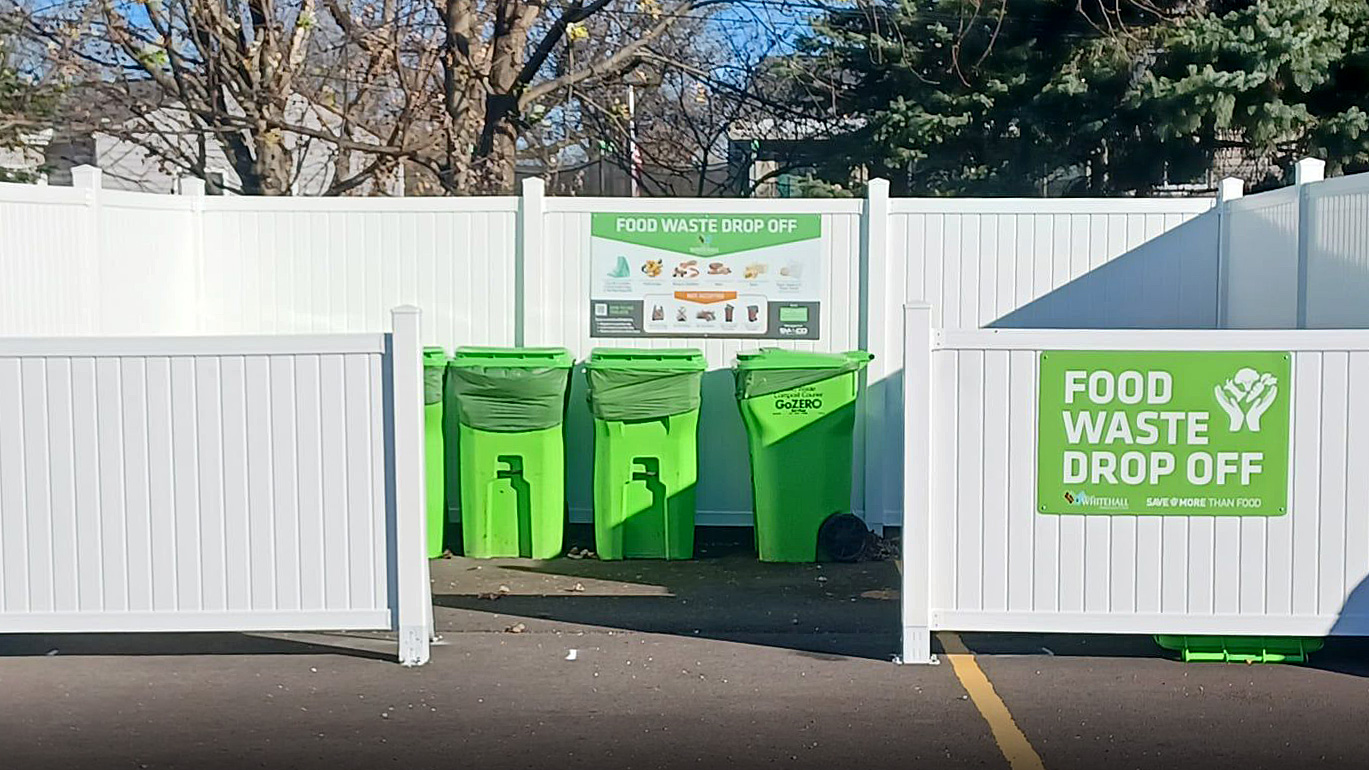Top: Grant recipients have found that it is best to have the drop-off site(s) available 24 hours a day and not place the location behind a gate that limits access.
J. Boehm, L. Schroeder, K. Higginbotham and A. Booker
Interest in residential food waste recycling has been growing over the past five years in Franklin County, Ohio. Backyard composting has always been an option for residents that have sufficient yard space and the motivation to manage a backyard bin. A number of vendors now provide residential curbside collection of food waste for residents who are willing to pay for the service. These options, however, are not practical for all residents.
As a result, several Franklin County communities have established free public Food Waste Drop-offs for residents to collect food scraps at home and deliver them to the drop-off location at their convenience. To help communities establish a program that works for them, the Solid Waste Authority of Central Ohio (SWACO) provides grants to communities within its jurisdiction to fund the first year of a residential food waste drop-off program or a program expansion, as well as plan, implement and monitor the program. This article is excerpted from “Food Waste Drop-Off Program: Best Practices for Central Ohio Communities,” a record of best practices we’ve identified along the way.
Choosing A Name
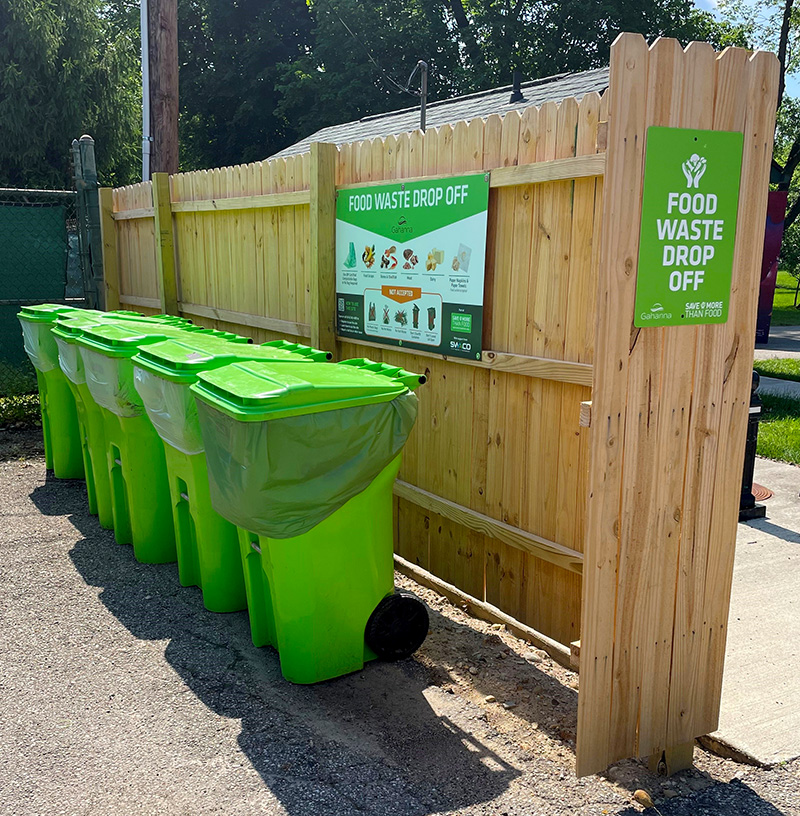
There is no easy rule of thumb to project capacity needs, but plan for more than needed. Photos courtesy of the Solid Waste Authority of Central Ohio (SWACO)
We recommend calling drop-off sites a “Food Waste Drop-off” and referring to the program as the “Food Waste Drop-off Program” or “Food Waste Collection Program.” Calling the sites “Compost Drop-Off” may confuse residents as the bins themselves are places to drop off food waste, not a place to drop off all organic materials (like yard trimmings) or a place to get compost. The term “Composting Program” is not recommended as the collection program functions to collect food waste for later processing and does not deal with creating compost directly. The term “Food Scraps Drop-Off” is equally well suited to describe these collection sites, however in Franklin County, the term “Food Waste Drop-Off” was chosen by early programs and thus promoted for consistency. Using the same terminology keeps messaging consistent across communities so that these drop-off sites are immediately recognizable for residents who’ve moved from another community.
Capacity Planning
The number of containers needed for the volume of residential material collected at a given site depends on a variety of factors. There is no easy rule of thumb to project capacity needs, but plan for more than needed. Nothing will kill a drop-off program faster than overflowing bins resulting in rodents and odor issues. Factors to consider when estimating capacity include budget for offering the program; number of sites you want to collect from; how widely it will be promoted; and weekly versus biweekly pick up.
Start-Up And Management Strategies
When designing the drop-off program, select the right system and promotional activities to grow at a manageable rate. Consider the following:
- Require Registration: Requiring registration has a number of benefits. Limiting services to registered members provides greater control over the growth of the program and helps ensure that drop-off sites are not overwhelmed. The registration process also creates an email list that enables ongoing communication with participants as the program evolves, e.g., emailing about contamination issues, service updates and educational information including resources for food waste prevention. While you may not be able to enforce use of the program only by registrants (unless bins with key codes are used), you can still instruct residents to register to maximize the number of site users who do. Use language that instructs, rather than “suggests” or “asks” participants to register.
- Provide Signage with Clear Instructions at the Drop-off Site: Signage serves as one point of instruction for the use of the site. SWACO’s signage has been created with our partners and follows best practices; it is available to download and print. Additional instruction can be provided by email to residents who register for the program or along with equipment, e.g., a countertop container, if any is being provided to residents. See below for more discussion about signage.
- Outreach and Education: Use a community webpage, social media, resident workshops, and/or email and newsletters. A QR code on signage at the drop-off site can serve as an ongoing way to communicate about the program.
- Provide Equipment: Offering buckets and/or compostable liners can make collection and delivery easier for residents. The buckets also create a great opportunity to include educational materials about what items are and are not accepted in the program. Providing buckets also helps establish a baseline for the number of participants, at least initially. If no formal registration is required to use the drop-off program, a one-time bucket giveaway to early adopters to kick-off and promote it creates an opportunity to ask for voluntary email addresses to enable ongoing communication with site users.
- Engage Decision Makers: Providing buckets to council members to “beta test” the program can be a great way to engage influential individuals and build support for the program.
- Business Sponsorships: Consider sponsorship opportunities for local business to help support the program. For example, are there local restaurants in your area that have “pickle buckets” from food items they purchase and would be willing to donate them to your community to give away to residents for collecting and transporting their food waste? What about local hardware stores or other businesses that could co-brand the buckets?
Promotion
Communities have generally found that promotion of the program is easy and inexpensive. Once initial promotion has resulted in adequate usage of the location, ongoing promotion can generally be light, using the same techniques as the initial outreach. Avoid promoting the program further unless there is adequate capacity to accept greater amounts of material at the site.
For new locations, some communities have started initial education by narrowly focusing on food scraps, as opposed to other compostable items such as soiled pizza boxes and uncoated paper products, until frequency of collection and needed cart capacity is established. Once usage of the location has settled in, the promoted list of acceptable items can be broadened to include some non-food scrap items. Many communities have maintained a food scrap focus in order to prioritize recovery of high nutrient materials, especially since compostable packaging and soiled cardboard are bulky items that can quickly eat up capacity of a given site.
Site Location and Design
A typical food waste drop-off consists of six to eight 64-gallon wheeled, lidded containers that are serviced on a regular schedule by a service provider and the food waste is transported to a registered compost facility for composting. Several factors should be considered when thinking about the infrastructure necessary for a successful program.
Location: An ideal location is convenient to residents but not too exposed to public traffic to cause problems. Our grant recipients have found that it is best to have the site(s) available 24 hours a day and not place the location behind a gate that limits access. An ideal location might be:
- Adjacent to a public facility, so that it is easy to monitor
- Adjacent to a facility that residents regularly visit like a recreation center, church, or park so that visiting is convenient. If the site is in a high visibility area with a lot of traffic from passers-by, placing a trash can nearby can help cut down contamination.
- Easy for residents using different modes of transportation to access (walking, bike, vehicular) without disrupting existing uses of the area
- Easy to find if you know where to look, but somewhat out of the way from unrelated public traffic (not too noticeable if you’re not looking for it)
Frequency of Pick Up: Drop-offs are serviced either weekly or every other week. All communities thus far have chosen weekly pick-ups as a way to increase capacity without increasing the size of drop-off sites. More frequent pick-ups also help cut down on odors and make insect issues exceedingly rare. Your service provider should work with you to initially set up and adjust service needs.
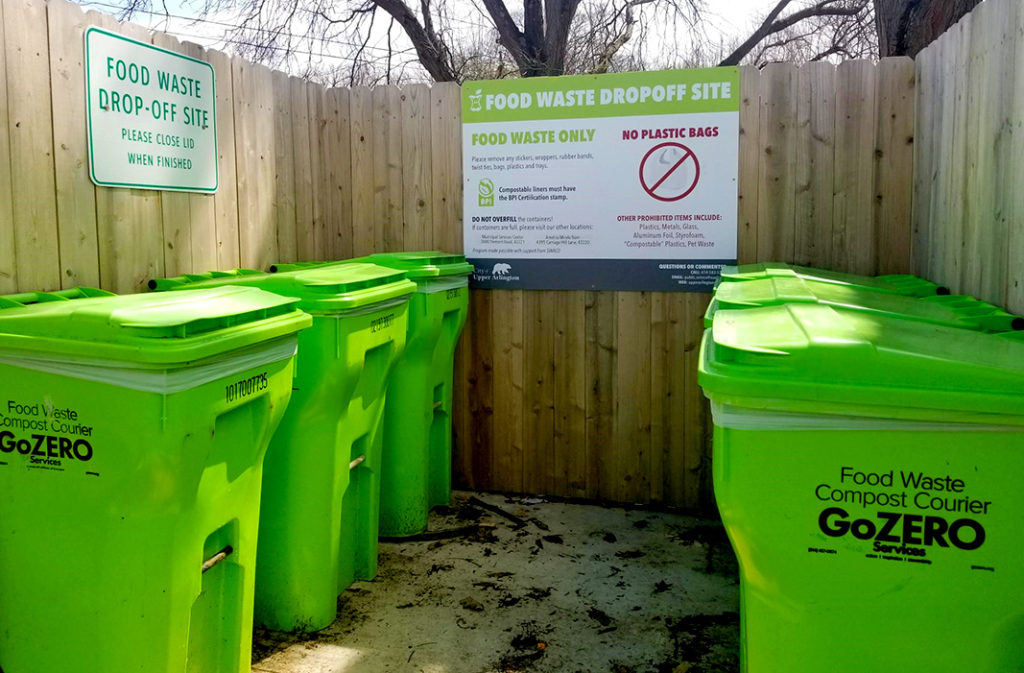
All communities thus far have chosen weekly pick-ups as a way to increase capacity without increasing the size of drop-off sites.
Enclosures: While not a necessity, a simple enclosure around a drop-off location is beneficial for screening purposes. Creating a defined collection area using an enclosure provides a clean and organized look to the site, which may encourage more careful use of the containers and attention to avoiding contamination — especially if other streams (e.g., recyclables) are collected in the same area. Aesthetically, an enclosure creates some visual screening of the location, and it allows for the easy placement of signage. The cost to construct an enclosure will vary depending on its size and complexity, but a simple enclosure has been constructed for $500 to $750 in materials. Examples from Central Ohio communities offer site design ideas.
Signage
Educational signage at the drop-off location should be installed to instruct residents on proper use of the site. Food waste haulers typically provide instructions for what types of food scraps they accept. Ask them what instructional materials they have to offer residents. A QR code offers a flexible way of sharing information about how to use the site, report an issue or a full bin, sign up to receive emails about food waste reduction/composting/green initiatives, and learn who to direct questions to/allow for feedback on the program.
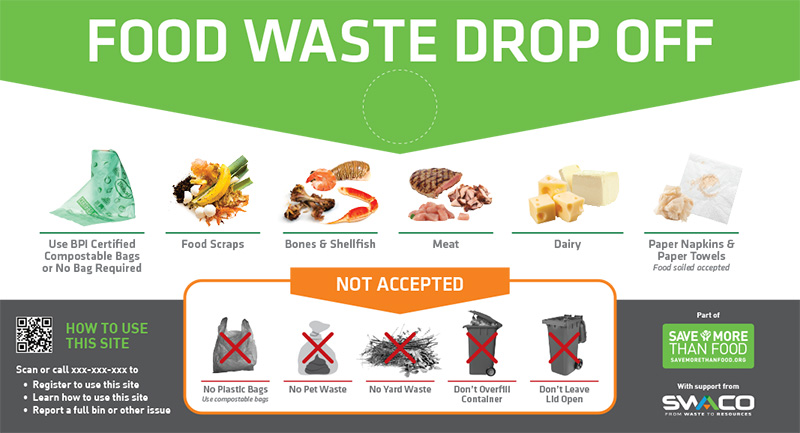
SWACO’s signage has been created with input from its partners and is required to be used by grant recipients at their drop-off sites.
SWACO’s signage has been created with input from its partners and is required to be used by grant recipients at their drop-off sites. Using this signage maintains consistent messaging and recognition of community food waste collection programs across the region. This signage is available to others outside of Franklin County as well.
Communities to date have primarily focused their signage on food scraps and soiled napkins and have excluded bulkier or potentially confusing compostable items (pizza boxes, uncoated paper products, compostable cutlery and containers) for several reasons: Food waste collection services are currently expensive and with limited capacity for collection, capturing high nutrient food scraps is prioritized; pizza boxes and containers take up a lot of volume and could overwhelm limited cart space; and the average resident may find it difficult to identify certified compostable cutlery or containers from its plastic counterparts. If accepting these items, specify that only BPI-certified compostables are accepted. Additional education may be required.
If you are developing your own signage, use simple language and realistic images, and focus on what should not be placed in the container. Limit words so that signage is quickly understandable. Some communities have promoted their vendor’s website to their residents as the “go to” source of information about what can and cannot be composted through their program.
Program Maintenance
Measurement is key to managing, growing, and improving your program. If registration isn’t required, the number of participants can be estimated based on the tonnage collected, using a conversion factor provided by your service provider. Track the tons collected per month and per year, as well as seasonal fluctuations. Gather feedback from program participants via an email survey one year after launching the food waste collection program and periodically to understand challenges and needs.
In terms of monitoring and site management, the first round of residents who utilize food waste drop-off programs are highly motivated — they have voluntarily decided to collect food waste from home and transport it to the drop-off location. As a result, they generally take the time to understand the rules and follow them. Knowledge gained across grant communities in Central Ohio includes:
- Contamination has been very low, likely because early adopters are going out of their way to use the site and are already somewhat knowledgeable or interested in food waste diversion. Nevertheless, monitoring the site is important to catch contamination and take immediate action to remedy the cause.
- The most prevalent contaminant may be plastic non-compostable bags. Keep an eye out for these in the containers. Additional signage may be necessary to provide constant reminders to participants.
- Spraying drop-off bins and the contents with household vinegar can help to reduce any odor and insect issues. This may be particularly important in summer months. Ask if your hauler sprays down bins or provides a new bin with every service.
Even for motivated participants there is likely to be some confusion about what can and cannot be composted. Continued communication on what should and should not be discarded as part of the program and sharing progress reports on food waste diversion will help keep participants engaged and contamination rates low.
Food waste collection service providers are a critical component of program success and should be able to help identify capacity needs and frequency of collection. Develop a strong relationship with them — including regular, ongoing communication — and use their knowledge and experience to improve your program. During the first year of operation, quarterly meetings to discuss the program are recommended. In addition, request regular reports documenting the material collected from the drop-off site. At a minimum, the reports should include every pick-up made; weight of material collected from the site; a rating or report of contamination on every pick-up; and photos of any contamination that is identified.
Final Tip
To avoid having the drop-off site inundated in the fall, over communicate whether pumpkins are allowed well in advance of Halloween. In 2021, the City of Upper Arlington collected 32 tons of pumpkins over 6 weeks starting in early November. Two 20-yard roll-off containers were co-located next to the drop-off site and hauled to a local composting operation as they filled up. A local waste hauler was contracted to haul the material.
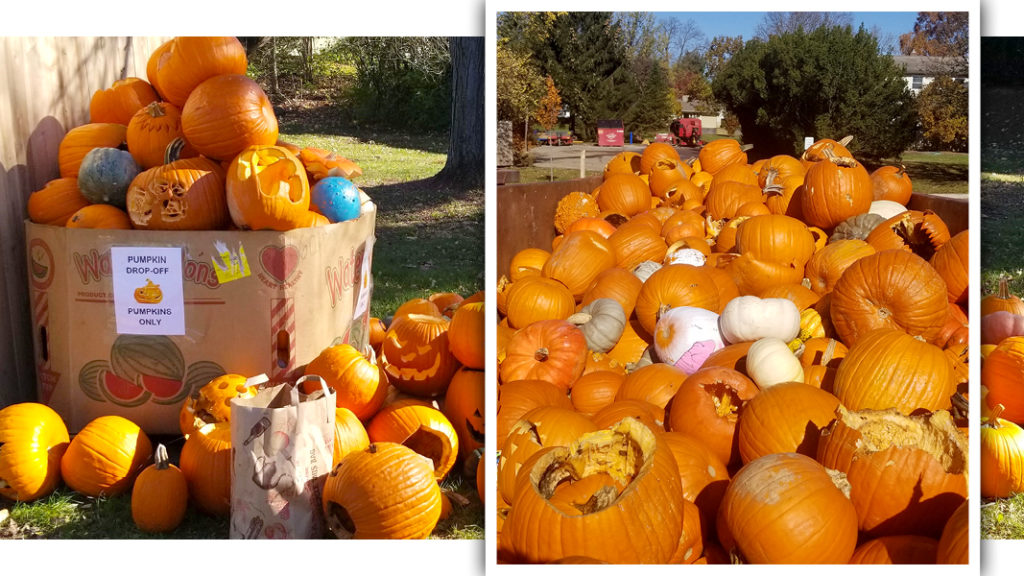
The City of Upper Arlington created a separate area for drop-off of pumpkins. Photos courtesy of City of Upper Arlington
All components of the Food Waste Drop-Off Program Best Practices guide are linked in the downloadable PDF. On the last page, under the heading “Additional Questions”, the last link provides site signage available to use.
Jane Boehm is the Food Waste Programs Coordinator at SWACO, the Solid Waste Authority of Central Ohio. The Best Practices guide has benefited from contributions and edits from previous authors including Lucy Schroeder, former Food Waste Coordinator, and editors Kristi Higginbotham and Andrew Booker, SWACO’s School and Grants Administrator and Program Manager, respectively.


